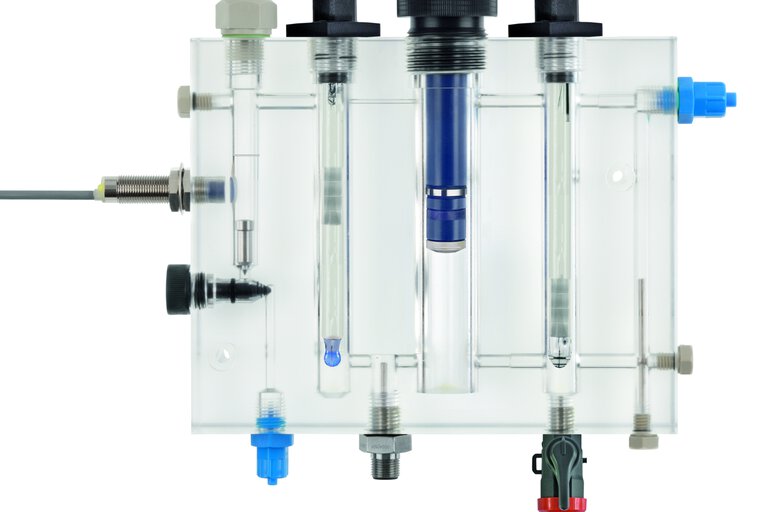

Immersion fittings for pH or redox electrodes - applications, types and installation
Would you like to find out how to correctly install an electrode in a submersible fitting? Are you interested in what the different types of immersion fittings are? If the answer is yes, then this blog post is for you! From it, you will learn how they work, what applications they have and how to install electrodes in them step by step. Read on!
Immersion fittings - principle and application
Immersion fittings are specialised sheaths used to place sensors, such as pH electrodes, redox electrodes or thermometers, directly into a liquid. Its main purpose is to provide a stable and safe environment for these sensors and their lines, allowing accurate and uninterrupted measurements of various liquid parameters. Thanks to their suitable design, these fittings protect the glass electrodes from mechanical damage, including breakage, chemical influences, and also ensure their correct positioning in the medium under test. Typical applications for immersion fittings range from the chemical, pharmaceutical and food industries to wastewater treatment plants.

Immersion fitting for measuring 3 measuring electrodes
Types of immersion fittings
We offer a variety of immersion fittings designed for analytical measurements in liquids, suitable for installation in channels and open tanks:
- Standard Fitting: Can be mounted from the side of the tank or through the cover, submersible to a depth of up to 2 meters.
- Versions for 1 or 3 Electrodes: Versions are available that allow the mounting of one electrode (e.g., pH only) or three electrodes simultaneously (e.g., redox, temperature, and conductivity).
- Version with a Moisture-Maintaining Cradle: Features a float that rises when there is a medium in the tank. When the tank is empty, the float falls, and the cradle closes, keeping the electrode in a moist environment and preventing it from drying out.
- Fitting with Suspension: Ideal for applications in measurement cranes, for example, at sewage treatment plants.
- Version with a Cleaning Tube: Equipped with a side tube for the introduction of air or water, useful for cleaning electrodes in conditions where sticky media may be present.
- Fitting with a KCL Reservoir: Intended for applications with low conductivity (below 300 microsiemens).
All our immersion fittings are adapted to electrodes with a pH13.5 mounting thread, which is standard in our blackLINE series. Additionally, we offer fittings made of acid-resistant steel, perfect for applications where plastic fittings cannot be used.
Due to the standard design of redekos, pH, conductivity, and temperature compensation thermometers from the ecoLINE and blackLine pH series (120 mm length, 12 mm diameter, PG 13.5 thread), they fit all our fittings.

Types of JUMO immersion fittings with, among others, a cleaning tube and a humidity cradle
Installation of electrodes in fittings step by step
We present the process of installing electrodes in fittings step by step:
- Preparing the Electrode: Ensure that the electrode is clean and ready for installation. Check for any damages.
- Preparing the Fitting: Verify that the fitting is clean and all its components are in good condition. Ensure that the fitting is suitable for the chosen electrode.
- Screwing in the Electrode: Carefully screw the electrode into the fitting, paying attention not to damage the thread. For fittings with a PG 13.5 thread, the electrode should fit without any problem.
- Securing the Seal: In some fittings, there is a sealing ring or another sealing mechanism that ensures a tight connection between the electrode and the fitting. Make sure the seal is properly positioned and not damaged.
- Connecting the Cable: If the electrode requires an electrical connection, gently connect the cable to the electrode. Be careful not to twist the cable while screwing.
- Checking the Installation: After installation, check that the electrode is properly secured and that there are no loose parts.
- Securing the Connection: In some cases, such as when installing in tanks where the liquid level might be higher than the electrical connection of the electrode, ensure that the connection is adequately secured, for example, using a cable gland.
- Mounting in the Tank or System: The fitting with the electrode can then be installed in the appropriate location in the tank or system, using the appropriate clamps or supports, depending on the specific application.
Remember that each installation may require specific steps depending on the type of fitting, electrode, and the environment in which they will be used. It is always worth consulting the instructions or our specialist to conduct the correct installation.
About the author
My name is Ewelina Szmit and I have been working in the field of content marketing for several years, combining my professional skills with my passion for writing. I believe that even the most technical topics can be presented in a way that is interesting and accessible to everyone. Outside of work, I develop my creativity by making newspaper collages. I like to spend my free time most actively, walking my dog or running.

Technical person
Katarzyna Tracz - Inside Sales Engineer +48 71 339 32 86 Katarzyna.Tracz@JUMO.net +48 71 339 32 86Comments
We encourage you to leave your comments via the form below. They will be posted online once they have been approved through our review process.


